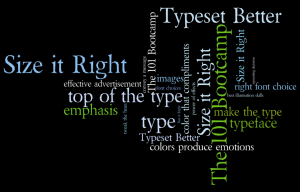 When it comes to effective advertisement, we like to say that the font choices and typesetting decisions you make are the only things that matter. And for the most part, it’s very true. You can have the best illustration skills in the entire world, but without the right font choice—or correct type design—you’ll quickly find your work being rejected. What’s the fix for this? Why, a quick perusal of our tips below! Starting with:
When it comes to effective advertisement, we like to say that the font choices and typesetting decisions you make are the only things that matter. And for the most part, it’s very true. You can have the best illustration skills in the entire world, but without the right font choice—or correct type design—you’ll quickly find your work being rejected. What’s the fix for this? Why, a quick perusal of our tips below! Starting with:
- Choose Colors Wisely: Let’s say you’re creating an advert for a chocolate-based client. The piece understandably includes lots of images of chocolate, as well as a pretty heavy emphasis on the brown end of the color wheel. When setting your typeface, be sure to use a color that compliments this structure. Use a similar brown to the advertisement, but one that’s slightly different, allowing it to stand out from the background. Additionally, where possible try to use colors that evoke an emotion similar to the strength of the entire advert. What we mean is, colors produce emotions in most viewers, and if you’re aware of this, you can tweak the hues to convey a message without saying a thing in text.
- Use Better Effects: Another great way to beef up your type is to understand the overwhelming power of effects. Are you creating a retro style logo for a client? Why not sprinkle a little white noise over the top of the type in the form of grungy paint splotches or some variety of textured paper. Make the type look older and we promise the rest of the design will benefit. Furthermore, what can you do to your type to make it fit best with the rest of the piece? Will adding some engaging illustrations to one or a few of the letters set the whole thing ablaze? Can you tweak the type itself slightly to produce a unique effect? Considering modifying the type in unique but advert-oriented ways to truly bring your work to life.
- Size it Right: Lastly, size really does matter! We know clients are always asking you to turn up the size on your work but if your copy is too small to read it won’t get noticed. On the other hand, one that’s too large can overwhelm the piece and detract from the other work you’ve created. In essence, just use your eye and a bit of common sense.


